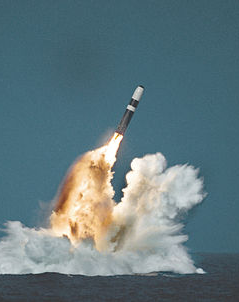
UGM-133 Trident II
USINFO | 2013-10-09 14:11
UGM-133 Trident II, or Trident D5 is a submarine-launched ballistic missile, built by Lockheed Martin Space Systems in Sunnyvale, California, and deployed with the US and Royal Navies. It was first deployed in 1990, and is still in service.
Trident II was designed to be more sophisticated than Trident I, and have a greater payload capacity. It is accurate enough to be used as a first strike weapon. All three stages of the Trident II are made of graphite epoxy, making the missile much lighter than its predecessor. Trident II missiles are carried by US Ohio and British Vanguard-class submarines. USS Tennessee (SSBN-734) was the first submarine to be armed with Trident IIs. Trident II missiles are currently carried by fourteen Ohio class and four Vanguard-class SSBNs. There have been 143 consecutive successful test flights [1] of the D5 missile since 1989, with the most recent being from HMS Vigilant in October 2012.
The development contract for Trident II was issued in October 1983. The first Trident II launch occurred in January 1987, and the first submarine launch was attempted by Tennessee, the first D-5 ship of the Ohio class, in March 1989. The launch attempt failed because the plume of water following the missile rose to greater height than expected, resulting in water being in the nozzle when the motor ignited. Once the problem was understood relatively simple changes were very quickly made but the problem delayed the Initial Operational Capability (IOC) of Trident II until March 1990.[2]
It is estimated that 540 missiles will be built by 2013. The Trident D5LE (life-extension) version will remain in service until 2042.[3]
Specifications
- Purpose: Strategic Nuclear Deterrence
- Unit Cost: US$ 30.9 million
- Range: Varies, based on payload, but rumored to be up to 11,300 kilometres (7,000 mi)
- Maximum speed: > 6,000 metres per second (22,000 km/h; 13,000 mph).[2]
- Guidance system: inertial, with Star-Sighting; GPS experiments done but not deployed.
- CEP: Requirement: 90–120 metres (300–390 ft).[2] That demonstrated by flight tests is classified, but rumored to be significantly better.
- Warhead (in USA usage only): nuclear MIRV up to eight W88 (475 kt) warheads (Mark 5) or eight W76 (100 kt) warheads (Mark 4). The Trident II can carry 12 MIRV warheads but START I reduces this to eight and SORT reduces this yet further to four or five. New START provides for further reductions in deployed launch vehicles, limiting the number of Submarine-launched ballistic missiles (SLBM) to 288, and the number of deployed SLBM warheads to a total of 1,152.
Submarines currently armed with Trident II missiles
United States Navy
United States Navy
- Alabama (SSBN-731)
- Alaska (SSBN-732)
- Henry M. Jackson (SSBN-730)
- Kentucky (SSBN-737)
- Louisiana (SSBN-743)
- Maine (SSBN-741)
- Maryland (SSBN-738)
- Nebraska (SSBN-739)
- Nevada (SSBN-733)
- Pennsylvania (SSBN-735)
- Rhode Island (SSBN-740)
- Tennessee (SSBN-734)
- West Virginia (SSBN-736)
- Wyoming (SSBN-742)
 Royal Navy
Royal Navy- Vanguard
- Vengeance
- Victorious
- Vigilant
Share this page




















